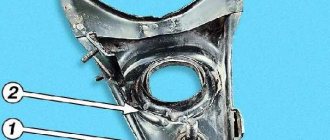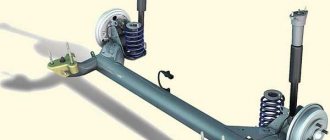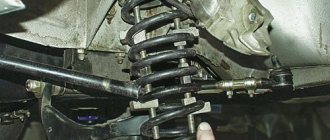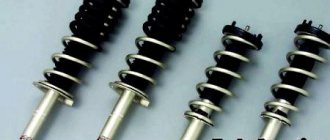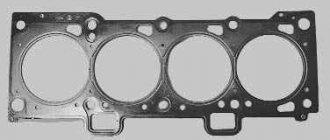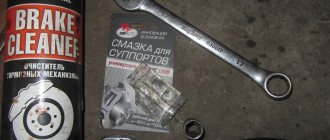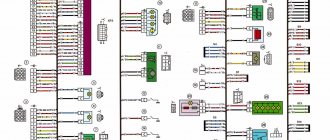The principle of operation of the rear struts differs little from car to car. The station wagon leaves the machine with a two-pipe hydraulic design that absorbs shock loads due to oil resistance to the cylinder piston. From the outside, these elements look like a pump, only instead of air there is a viscous liquid.
Removing and installing front suspension springs on Priora
So, to remove the springs, you must first remove the front suspension modules from the car. More information about this is written in this article on replacing the front struts on a Priora.
When the modules are removed, it is necessary to loosen the nut of the strut rod, holding the rod itself from turning with a hexagon:
After this, compress the springs using special ties.
Compress the spring until it no longer exerts pressure on the support.
When the spring is sufficiently tightened, unscrew the upper rod nut completely.
Next, you need to remove the nut along with the washer, and then lift the support assembly with the bearing:
After which we also remove the cup and rubber gasket:
Now you can remove the spring, since nothing else prevents its removal:
Installing a new spring occurs in the reverse order. Of course, to do this it is necessary to pull it to the same level as when removing the old one in order to put the support with the bearing in place and tighten it with a nut.
The price of a new spring on a Priora ranges from 1,000 rubles for a standard factory spring, and up to 2,500 rubles for various modifications from other manufacturers, such as SS20 or Acomi.
The rear springs on a Lada Priora car must be changed in pairs on each side, regardless of the technical condition of the second. Repair work is carried out when the springs have sagged, as a result of which the rear part of the body has sagged, in case of mechanical damage, or vice versa in order to raise the body by installing longer springs and additional rubber linings. To carry out repair work, prepare a standard set of tools and perform the following sequence of actions:
- First of all, it is necessary to dismantle the decorative trim of the luggage compartment in order to free the cups in order to unscrew the nuts securing the upper shock absorber rod.
- Next, lift the rear part of the body and remove the wheel.
- Then unscrew the nut of the lower bolt securing the shock absorber to the rear axle bracket and remove it together with the spring.
- Next, remove the rubber lining from the glass.
- Remove the spring from the strut. Replace it. Also, if necessary, replace the rubber gaskets.
- For ease of subsequent installation, the rubber gasket on the spring must be secured with electrical tape or tied with nylon thread. Also, when placing the spring itself on the stand, orient it so that its end fits exactly into the slot on the support cup, similarly with the rubber gasket.
- Next we proceed to the installation. For ease of installation, the shock absorber rod must be completely removed, after which, placing its end in the hole in the body shell, fix it with a nut in the car interior and only then fasten the lower bracket.
Disassembly of the structure
1. Take the spring tie prepared earlier and install it on the second coil of the spring from above and below as shown in the photo. The second screed is installed on the other side symmetrically to the first. The process of bringing the spring together is carried out as follows - tighten the bolts of the first tie until you feel that the second one begins to move freely on the coils, then tighten it until you remove the load from the previous one. That is, in turn on each side.
2. Take the “22” socket and hexagon and unscrew the fastening nut that secures the strut rod to the support.
3. Remove the limiter (bump stop), support bearing, support, and compression limiter.
4. Replace the old rebound limiter washers with those that came with the Acomi struts
Please note - the bottom one is smaller than the top one
5. Next, remove the spring cup with rubber damper, compression buffer, spring and boot.
Now it is necessary to carry out a visual inspection of the dismantled rack.
The first test of swinging the rod to the top point demonstrated the cause of the malfunction. The resistance in the upper part of the working area quickly disappeared, after which the piston hit the upper part of the cylinder. As you understand, this was the source of the dull knocks.
Features of replacing racks
Lada Priora rear suspension parts: 1 – rubber-metal hinge;
2 – suspension arm mounting bracket; 3 – shock absorber casing; 4 – compression stroke buffer; 5 – casing cover; 6 – support washer; 7 – shock absorber cushions; 8 – spacer sleeve; 9 – shock absorber; 10 – insulating gasket; 11 – rear suspension spring; 12 – lever connector; 13 – lever of the rear suspension beam; 14 – shock absorber mounting bracket; 15 – flange; 16 – lever bushing The first generation of Priora, which debuted in the nineties, caused a lot of criticism regarding the struts and suspension. The car did not have a good chassis, it swayed, and maneuverability was not at the best level. At the beginning of the two thousandth there was a stage of restyling, which took the car along reformist paths. Now the racks have become more reliable, and the power unit is more powerful. But nevertheless, professionals propose to improve the restyled version by replacing the struts, since then its performance will be significantly improved. Although over time, replacement of parts is necessary in any case.
Replacing struts on a Priora is based on one factor: in what conditions the car will be used. Each rack has its own design differences, pros and cons, technical features, and if one type is good in one situation, then it is unlikely to be effective in another. So this should be taken into account without fail.
Before you decide to replace parts, you should be 100% sure of this. You can check the working condition of the racks in a very simple, old-fashioned way. You'll have to rock the corner of the car a little. Now count the number of free jumps. If one, then the system is normal. If there is more than one, then urgent replacement of the racks is required, since the old ones can no longer cope with the task assigned to them.
When replacing old parts, you should also take into account that oil struts, despite their affordable price, are less effective, especially in frosty weather. Gas-oil shock absorbers are somewhat more complex and expensive, but they will please you with good performance
It is only worth noting that imported spare parts are significantly better than domestic ones. Therefore, professionals, as a rule, install Kayaba struts on Priora.
"Bogdan"
The coexistence of the previous model and the new one in the same market is a worldwide practice. As soon as the new version finally puts the previous one to shame, production of the old model is stopped or transferred to other countries. So the painfully dear sedans and station wagons of the tenth family, having left the assembly line in Togliatti, appeared in the model range of the Ukrainian corporation Bogdan.
The new VIN code did not scare off fans: in Russia alone in 2010, more than 5 thousand Extogliatti small cars were sold, and in the first half of 2011 - more than 3 thousand. Since we have a dime a dozen sedans in this class, we decided to understand why aliens from the past captivate buyers using the example of the Bogdan-2111 station wagon and its direct relative, the Lada-Priora.
In Russia, the tenth family left the main conveyor in stages. In 2007, the sedan left the scene. The hatchback and station wagon lasted two years longer, then the family finally gave way to the Priora. Although the factory stubbornly insists that this is not a restyling, but a radically redesigned car, the buyer is skeptical about such statements.
practical guide
It is convenient to carry out the work in an inspection ditch. The work is shown on a car with a hatchback body. On a station wagon, the work is performed in the same way. On a sedan car, access to the upper shock absorber mount is through the luggage compartment.
Replace shock absorbers and springs in pairs.
To complete the work you will need:
— inspection ditch or overpass;
— a device for disassembling suspension struts.
We carry out the work with an assistant.
Removal
1. Prepare the car for work and hang the rear of the car on stands.
If there is no inspection ditch or overpass, remove the rear wheel of the car from the side of the shock absorber being replaced.
2. Remove the luggage compartment shelf.
3. Fold down the back seat.
4. In the luggage compartment, use a Phillips screwdriver to remove the four screws securing the upholstery.
5. Use a screwdriver to pry off the trim of the seat back lock.
6. Using a 19 mm wrench, unscrew the lock and remove it.
7. Using a Phillips screwdriver, unscrew the screw securing the luggage compartment lining.
8. Bend down the luggage compartment upholstery.
9. Use a Phillips screwdriver to unscrew the top screw securing the cladding.
10. Using a Phillips screwdriver, unscrew the two lower screws securing the cladding.
11. Move down the luggage compartment lining.
12. Using a 13 mm socket wrench, unscrew the two nuts securing the seat back clamp bracket.
13. Remove the retainer bracket.
14. Using a slotted screwdriver, remove the plug.
15. While holding the shock absorber rod from turning with a 6 mm wrench, unscrew its nut with a 17 mm wrench.
16. Use a magnet to remove the spring washer and the upper support washer from the shock absorber rod.
17. Remove the upper rod mounting pad from the shock absorber rod.
18. Using two 19 mm wrenches, unscrew the nut of the bolt securing the lower end of the shock absorber to the rear axle beam and remove the bolt.
19. Move the lower end of the shock absorber towards the rear of the car and remove the shock absorber.
20. Remove the spring and its gasket from the shock absorber, and also, if necessary, remove the lower cushion and spacer from the shock absorber rod.
Installation
Springs of the same class (with the same color marks) should be installed in the rear suspension of the car.
1. Before installing the shock absorber, secure the rubber gasket 4 to the spring 2 with insulating tape or tape.
2. Install the spring on the shock absorber and fully extend the rod. We put a buffer 1, a protective casing 3 with a cover, a spacer sleeve 5 and a lower cushion 6 (if they are not on the rod) onto the shock absorber rod.
When installing, the shock absorber must be oriented so that the end of the lower coil of the spring faces the wheel.
3. We insert the shock absorber rod into the hole in the body cup, at the same time an assistant puts the upper cushion and support washer on the rod and tightens the rod nut a few turns.
4. Raise the lever until the holes in the shock absorber and beam bracket align. Install the lower shock absorber mounting bolt and tighten its nut (without tightening).
If you don't have an assistant, you can first attach the shock absorber to the rear suspension beam. Then, placing a stop under the rear lever, smoothly lower the car on the jack, making sure that the shock absorber rod enters the hole in the body, and after that, put on the upper cushion with the support washer and tighten the nut.
5. Install the removed wheel (if the work was carried out without an inspection ditch) and lower the car onto the wheels. We press the rear of the car several times to self-install the suspension elements.
6. Tighten the shock absorber rod mounting nut to a torque of 50-61.7 Nm (5.1-6.3 kgcm).
7. Tighten the nut of the shock absorber lower mounting bolt to a torque of 66.6–82.3 Nm (6.8–8.4 kgcm).
Which ones to choose and their price
Having decided to replace the rear struts, you will have to choose among today's abundance of original spare parts and their analogues on sale. You can, of course, not bother and buy stock oil shock absorbers from the SAAZ plant, exactly the same as those installed on the Priora on the assembly line.
Part numbers:
- 217002915002;
- 217002915003;
- 217002915004;
Their prices vary from 1200 to 1400 rubles (for one rack).
If you want to change the characteristics of the suspension, namely make it softer or stiffer, you can purchase alternative struts. The most popular shock absorbers among Prior owners are SS20.
They are distinguished by high reliability, and in addition, a variety of designs that allow you to change the stiffness of the suspension. There are four modifications of SS20 for Priora on sale: “Comfort”, “Standard”, “Highway” and “Sport”, differing in rigidity in ascending order. The cost of a pair of such racks is about 3,700 rubles.
Important: it is recommended to replace shock absorbers in pairs, i.e. if you change it, then change it on both sides of one axis!
Bearing manufacturers
You need to select spare parts before replacing the bearings on the machine. Similar products are installed on Priora and Tens. The highest quality products are produced by the following companies:
- SKF.
- KOYO.
- SNR.
The cost of products is very high - this is a fact. But their service life is longer than that of their domestic counterparts. If you want to save money, purchase domestically produced products, their cost is about 500-700 rubles per piece. It is advisable to choose spare parts from those companies that are recommended by AvtoVAZ. Remember that installing a new bearing will ensure stable operation of the suspension and will eliminate rattling in the place where the strut is attached to the body for a long time.
Racks, what are they and why are they needed?
Struts are a mechanism whose task is to filter the shocks coming to the car when driving on a bad road. If the racks are of poor quality and not well-designed, then movement becomes a nightmare. This is why driving an expensive foreign car and a budget domestic car, which is sensitive to every bump, are so strikingly different.
The struts have a complex design, but the basis is a hollow piston system. The piston system is equipped with multiple parts that secure the racks to the car body, and inside it is filled with either gas-oil liquid or oil. The principle of operation of the struts is that the piston, when it starts to move, seems to break the impacts falling on it, reducing their force.
Front and rear struts, depending on the manufacturer, can last a different amount of time, for example, standard Saaz rear struts installed on Lada Kalina and Lada Priora can last 75,000 - 85,000 km, after which they require replacement. If you put new ones on a Lada or Priora, of better quality, then they will last 120,000 - 125,000 km, which is already an achievement.
On the Priora, as on other cars, problems with struts are expressed in oil leakage, insufficient adhesion of the tires to the road surface, and deterioration in maneuverability. Another sign of problems with the rear strut is a sudden, sharp increase in braking distance. According to professionals, if it is necessary to replace one rear strut, then it is wiser to change both at once, since otherwise there may be a mismatch of parts, which will lead to a significant deterioration in the operation of the entire system and a decrease in the dynamics, maneuverability and controllability of the car.
Basic faults
A beam can fail for two reasons:
- displacement from place;
- mechanical damage (most often a crack).
When a crack occurs in the lever, the torsional rigidity of the body decreases. This parameter determines the degree of safety, as well as the position of the parts. The fact is that with normal body rigidity, which is laid down during design and obtained after the final stage of car assembly, absolutely all components and assemblies (down to the bolts) are in place, they have a maximum permissible vibration amplitude. For example, the suspension “swallows” potholes - the parts actively move, and people in the cabin may not even notice the rolling.
In addition to the fact that you will most likely have to get used to unpleasant sounds, there will be increased wear and tear on small parts. When a lever cracks, everything that is attached to it begins to move with greater amplitude. The problem is temporarily solved by welding, but this only postpones the solution to the problem for some time. Craftsmen recommend changing the beam.
Ball joint, replacing the lower ball joint
Shock absorbers for the factory equipment of the car are manufactured at the Skopinsky Automotive Assembly Plant (SAAZ for short), located in the village of Chulkovo. SAAZ oil devices are reliable during operation at a calm driving pace. Their main advantage is their relatively low cost.
This plant also produces gas-oil models, in which, in addition to oil, inert gas is pumped. Gas-oil SAAZ models are distinguished by increased combat forces. They better press the wheels to the road surface. This makes the entire suspension stiffer, so the car is more stable when driving fast and when cornering.
| Installation location | Product code | Rod diameter, mm | Case diameter, mm | Case height, mm | Rod stroke, mm |
| Front | 21236290500400X | 12,5 | 45 | 231 | 118 |
| Rear | 212302915004000 | 12,5 | 45 | 326 | 200 |
Chevrolet Niva owners have a question about which of the options offered on the Russian market are the best. There is no clear answer here. It all depends on the conditions in which the car is operated. Based on the requirements, they already choose a specific brand.
The cause of shock absorber malfunction can be various factors:
- gas leak;
- failure of silent blocks;
- torn oil seal;
- deformation of valve plates;
- aging of fluid in the shock absorber.
Signs of a faulty car part on a Chevrolet Niva are easy to detect:
- When accelerating and braking, the car “squats”.
- when driving on an uneven surface, the suspension spring is compressed so that it reaches the limiter;
- oil leaks on auto parts and the entire suspension;
- drifts appear;
- the quality of wheel adhesion to the road surface decreases;
- The shaking inside the car increases.
Regardless of the quality of the shock absorber, as well as the operating conditions of the car, wear and tear on this part of the car occurs constantly. Therefore, regardless of the cause of the breakdown, it is recommended to immediately replace the failed device with a new one.
Before replacing a car part, you must prepare the following tools and materials:
- metal brush with stiff bristles;
- 2 socket wrenches with ratchet 19 x 2.
It is necessary to replace shock absorbers only comprehensively, that is, on both sides, even if only the front or rear car part is faulty.
The front suspension is considered more complex in design, so replacing the front shock absorber of a Niva Chevrolet will take more time (about 20-30 minutes) and effort, but the operating principle is the same.
Compatible parts are produced by dozens of manufacturers from Russia, Europe, America and China. Let's look at the three most common brands.
1. SAAZ (Skopinsky Automotive Aggregate Plant) is a company that was founded on the basis of an enterprise of the same name. Since the 50s of the last century, the company has been supplying auto parts for VAZ, GAZ and other domestic cars. The products of this company are in high demand, since many Shniv owners try to save money, and the quality of the parts is at an acceptable level.
2. SS20 (Technology System) is another Russian company founded in 1993. This Samara enterprise specializes in the manufacture of steering and suspension parts for Russian cars. Spare parts in the mid-price range are more reliable than SAAZ budget products.
3. KAYABA (Kayaba) is a Japanese company considered one of the best manufacturers of shock absorbers. The price of oil models is slightly different from SS20 products. Expensive gas-filled shock absorbers are specially designed to perform in harsh conditions. They help keep the car on sharp turns and on uneven roads. The quality of the brand is confirmed by the fact that KYB parts are installed on rally cars.
| Manufacturer | vendor code | Installation location | Type | Price, rub |
| SAAZ | 2123-2905402 | front | oil | 1070 |
| 2123-2915402 | rear | 1130 | ||
| 45-2905402-10 | front | gas-oil | 1090 | |
| 45.2915402-10 | rear | 1050 | ||
| KAYABA | 2123-2905004 | front | oil | 2230 |
| 2123-2915004 | rear | 2070 | ||
| 344441 | front | gas-oil | 3950 | |
| 344442 | rear | 4200 | ||
| SS20 | SS20171 | front | oil | 1800 |
| SS20174 | rear | 1900 | ||
| front | gas-oil | 1900 | ||
| rear | 1900 |
Also interesting: Niva 2121 suspension lift do-it-yourself drawings To replace the lower ball joint you will need the following tools:
- Hammer.
- Jack.
- Mount.
- Wire brush.
- Wrench for removing wheel nuts.
- Keys for "27", "22" and "13".
We unscrew the nut screwed onto the support pin and press the pin out of the steering knuckle socket. then we unscrew the nuts of the bolts that hold the lever on the support and, retracting the steering knuckle, pull out the bolts. We remove the wheel hub from the splines of the outer drive joint shank, then dismantle the ball joint and install everything in the reverse order.
What shock absorbers are suitable for Priora
Replacing rear shock absorbers directly depends on the conditions in which the Lada Priora is used. When the device becomes unusable, both the driver and passengers feel it. Therefore, you will think about a possible malfunction of the racks even before you arrive at the service center and undergo special diagnostics. You can feel the deterioration of the shock absorbers on the road. Your Priora will become less stable when maneuvering while driving at high speed.
Here are the rear struts on the car
In each case, replacing shock absorbers is an individual process. Factory parts, also called oil parts, are more affordable than their gas brothers. But they have one feature associated with a small temperature range. In winter, oil-filled shock absorbers become stiff. Therefore, such parts are offered by specialists only for urban vehicles.
Gas-oil shock absorbers will cost much more, but this price will fully correspond to their manufacturability. You will feel their role in the cold. Simply put, you will not feel any changes when the car moves, but this will be a confirmation of the quality of the rack. It is generally accepted that imported spare parts are reliable and made of high-quality materials, which is why Priora is equipped with Kayaba and SS20 shock absorbers.
Replacing old struts with new ones of improved quality does not guarantee perfect suspension performance. After all, this unit consists of many elements, and only a general replacement of parts can restore comfort and convenience in the process of driving the Priora. In principle, there is nothing complicated about how to replace rear shock absorbers on a front-wheel drive car. Therefore, this information will be useful not only to Priora owners. Drivers of other VAZ models can also use the instructions below.
Rear strut replacement process
https://youtube.com/watch?v=Y_vWs_YyuSQ
Chassis SS20
These spare parts for domestic and foreign cars are produced under the “System Technologies” brand. These racks have become so popular due to their high quality. For Priora, the manufacturer offers 4 product options that differ in hardness. Which stands are better? They need to be selected according to your driving style. The softest ones are the “Standard” series racks. Rear shock absorbers from the same series are also offered.
A reinforced version is offered to increase the load capacity. Next are the “Comfort” racks. According to reviews from many car owners, this is the best option. They are stiffer than the Standard, but the suspension works equally well on bad and good roads.
The “Highway” kit is suitable for those who like stiff suspension and high speed. With these racks you can drive on bad roads, but it will be uncomfortable. “Sport” is the toughest option from this manufacturer for Priora cars. A front suspension of this type is not very suitable for the city, but for sports competitions it is just right.
Lada Priora front suspension diagram
1 — steering knuckle; 2 - eccentric bolt; 3 — shock absorber strut; 4 — lever; 5 — stabilizer bar; 6 — mounting bracket for the stabilizer bar cushion; 7 — stabilizer bar strut; 8 — cross member of the front suspension; 9 — ball joint; 10 - stretching
1 — telescopic stand; 2 - spring; 3 — rod nut; 4 — rebound limiter of the upper support; 5 — upper support; 6 — bearing; 7 — upper spring cup; 8 — spring gasket; 9 — compression stroke limiter of the upper support; 10 — compression progress buffer; 11 - protective cover
1 — ball joint; 2 - hub; 3 — hub bearing nut; 4 — protective cap; 5 — hub bearing; 6 — steering knuckle; 7 - nut; 8 — front wheel brake disc; 9 — brake mechanism shield; 10 — eccentric (adjusting) bolt; 11 — rotary lever; 12 — front suspension spring; 13 — shock absorber rod; 14 — upper spring cup; 15 — upper support of the shock absorber strut; 16 — shock absorber rod nut; 17 — bearing of the upper support of the shock absorber strut; 18 — spring gasket; 19 — front suspension compression buffer; 20 — protective casing; 21 — rack body; 22 — bracket for mounting the anti-roll bar cushion; 23 — front suspension stretch; 24 — front wheel drive shaft; 25 — anti-roll bar; 26 — stabilizer bar; 27 — front suspension arm
Checking the condition of the chassis and transmission
We check the condition of the chassis and transmission every 15 thousand kilometers. The parts of the chassis (wheels, suspension arms, anti-roll bar, rear suspension beam, shock absorbers and suspension springs) and transmission (front wheel drive shafts) must be free of deformations, cracks and other mechanical damage that affect the shape and strength of the parts. Hanging the front wheels one by one (while the car must be securely fixed on the support stand), we check the condition of the wheel hub bearings.
Use only factory-made support stands. The wheel should rotate evenly by hand, without jamming or knocking.
Holding the wheel in a vertical plane, we alternately sharply pull the upper part of the wheel toward ourselves, and the lower part away from us, and vice versa. We make sure there is no play (knock). If there is a knock on the front wheel, ask an assistant to press the brake pedal. If the knocking noise disappears, then the wheel bearing is faulty, and if the knocking noise remains, then the ball joint is most likely worn out. The hub bearings of the front and rear wheels are not adjustable and must be replaced if there is play. To check the serviceability of the ball joint, insert a mounting blade between the suspension arm and the ball joint housing. Be careful not to damage the ball joint boot.
While pressing the lever with a mounting blade, we monitor the movement of the lever head relative to the ball joint housing. If there is play in the connection, replace the ball joint.
We check the condition of the protective covers of the ball joints. We replace ball joints with torn or cracked covers. To check the silent block of the front suspension arm...
...insert a mounting blade between the body bracket and the lever head... ...and try to move the lever along its axis and along the axis of the bolt. If the lever moves freely, without effort, it means that the silent block of the lever is badly worn or damaged and needs to be replaced. Ruptures, cracking and swelling of the rubber bushing of the silent block are unacceptable. Checking the condition of the silent blocks...
... and the back ends of stretch marks. Tearing, cracking and swelling of rubber silent blocks are unacceptable.
Inspecting the anti-roll bar cushions...
...and rubber bushings for stabilizer struts. If ruptures, cracks or severe deformation are detected on the rubber pads and bushings, they must be replaced. Lifting the rear wheels one by one, we check the condition of the rear wheel hub bearings. The wheel should rotate evenly by hand, without jamming or knocking. To check the condition of the silent block of the rear suspension beam arm...
...we insert the mounting blade between the body bracket and the lever head and try to move the lever in different directions. If the lever moves freely, without effort, it means that the silent block of the lever is badly worn or damaged and needs to be replaced.
We check the condition of the springs, telescopic struts and shock absorbers of the front and rear suspensions. The suspension springs must not be damaged. Tearing, cracking and severe deformation of rubber bushings, cushions and compression buffers of shock absorbers are unacceptable. Liquid leakage from shock absorbers is not allowed. A slight “fogging” of the shock absorber in its upper part, while maintaining the characteristics, is not a malfunction. If the rubber element of the upper support of the front suspension telescopic strut settles or is destroyed, the support must be replaced.
We check the condition of the hinges and the protective cover of the gear shift rod and jet rod. Alternately rotating and turning the front wheels (with the front of the car hanging out)…
...we inspect the protective covers of the outer...
...and internal hinges of the front wheel drives, check the reliability of their fastening with clamps. Covers that are cracked, torn or have lost elasticity must be replaced. We check that there is no oil leakage from the gearbox through the seals of the internal drive joints. If there is a leak, replace the seals.
The VAZ-2110 is considered the predecessor of the Lada Priora; their front suspensions are almost identical, the only differences are in the spring parts and shock-absorbing components. The problems that drivers noted with the VAZ-2110 with front suspension migrated to the Priora - the wheel bearings leave much to be desired, the ball joints wear out quickly and must be regularly replaced.
Work on replacing the rear struts of a Priora
In general, this is one of the simplest repairs on the Priora. Even a beginner driver can cope with it. For this process you need a simple set of tools: a wheel wrench, wrenches from 13 to 22, a hammer and pliers.
In general, fix the side where the shock absorber will be replaced as securely as possible.
So, everything is ready for replacement. First of all, remove the wheel. When access to the bottom of the rear pillar opens, unscrew the bolt securing the bushing in the socket. You may have to tap with a hammer. In this case, you should not unscrew the nut completely, but strike it so as not to damage the bolt. After the rod is removed, release the lower part of the rack and proceed to work in the cabin. Remove the decorative shelf under the rear window; under it there is the upper nut securing the compensator to the upper body support. Holding the rod, unscrew this nut with a 22mm wrench. That’s it, the rear strut comes out freely.
Installing a new part
It is necessary to start accordingly by fixing the upper part of the rod in the body. It is advisable to have an assistant here. One supports the compensator from below, and the second screws the nut into place. It must be borne in mind that it is necessary to ensure that the compensator spring is correctly positioned at this moment. Once the top nut is secured, insert the bottom of the rear strut into the groove and secure with a bolt and nut. Check tightness
Carefully lower the machine until the spring snaps into place. Secure the top fastener
The shock absorber replacement is complete.
The process is perfectly illustrated in the video below:
Which ones to choose and their price
Having decided to replace the rear struts, you will have to choose among today's abundance of original spare parts and their analogues on sale. You can, of course, not bother and buy stock oil shock absorbers from the SAAZ plant, exactly the same as those installed on the Priora on the assembly line.
Part numbers:
Their prices vary from 1200 to 1400 rubles (for one rack).
If you want to change the characteristics of the suspension, namely make it softer or stiffer, you can purchase alternative struts. The most popular shock absorbers among Prior owners are SS20.
They are distinguished by high reliability, and in addition, a variety of designs that allow you to change the stiffness of the suspension. There are four modifications of SS20 for Priora on sale: “Comfort”, “Standard”, “Highway” and “Sport”, differing in rigidity in ascending order. The cost of a pair of such racks is about 3,700 rubles.
"Technology System" – SS20
Important: it is recommended to replace shock absorbers in pairs, i.e. if you change it, then change it on both sides of one axis! To replace the rear struts yourself, you don’t have to go to a service station.
This process can be done at home and will not take more than an hour.
To replace the rear struts yourself, you do not need to go to a service station. This process can be done at home and will not take more than an hour.
Tools and tools you will need:
- jack;
- a “shoe” or an ordinary brick to block one of the wheels;
- wrenches at “6”, at “19”, at “22”;
- rust remover like WD-40;
- small mount.
Work order:
- Place the machine on level ground.
- Secure one of the front wheels with a “shoe” or brick.
- Open the luggage compartment lid, move the trim on one of the rear “glasses” at the place where the pillar is upper mounted.
- Using a wrench set to “22”, unscrew the nut securing the strut, holding the shock absorber rod with a wrench set to “6”.
- Using a jack, lift the car body from the side of the wheel where you plan to replace the strut.
- Having climbed under the car, unscrew the nut securing the lower part of the rack to the rear beam bracket with a “19” wrench.
- If the nut does not budge (soured), treat the threads around it with WD-40, let it penetrate the joint for about 20 minutes, then try again.
- When the nut is unscrewed, remove the bolt and remove the lower part of the shock absorber from the bracket. To simplify this process, you can use a small pry bar.
- Remove the shock absorber.
- Go to the trunk and remove the support washer and strut pad from where the upper part of the shock absorber is mounted.
- Remove the lower spring, cushion, bushing, boot and compression buffer from the shock absorber. If the boot, buffer, or shock absorber pads show signs of damage, they also need to be replaced.
- Carefully inspect the shock absorber spring. There should be no cracks, chips or other signs of destruction on it. If they are present, the spring must be replaced.
- Reassemble the new rack in reverse order.
- Install the new rack by first inserting its rod into the upper mount, and then securing the lower part into the bracket with a bolt.
- It is recommended to finally tighten all connections after the car body has been lowered, i.e. after you remove the jack.
- Upon completion of the work, rock the car body several times on the side where the rack was installed.
- After 100-150 km, tighten the shock absorber mounting nuts.
When to change
Factory SAAZ rear struts usually withstand 70-80 thousand kilometers, after which, according to the factory’s recommendations, they need to be replaced. But there is no point in changing shock absorbers if they do their job perfectly, unless you want to change the characteristics of the suspension.
It is not difficult to determine the serviceability of the racks yourself. As already mentioned, the first sign of their malfunction is a visible oil leak. In addition, faulty shock absorbers give themselves away with a characteristic dull knock in the area of the rear arches. This is also evidence of their depressurization and oil leakage.
You can verify that the racks are faulty in a simple way. Try rocking the left or right rear of the car. If it swung once and froze rigidly, it means that everything is in order with the shock absorber from which you rocked the body. If the car continues to rock, the shock absorber is faulty, and the body lowers and rises due to the spring.
Brief summary
As you can see, replacing the rear struts on a Priora is not particularly difficult. The main thing is to make the right choice and purchase shock absorbers that will last for many years, as well as diagnose them in a timely manner and prevent critical malfunctions.
The rear struts on the Priora, meaning high-quality factory ones, can last more than 200,000 km under normal operating conditions. Of course, not every car can boast of such mileage before replacing rear shock absorbers. If the racks no longer hold, and the back of your Priora begins to float, or its body is covered in oil (leaked), then they need to be replaced with new ones.
Each owner can replace these parts independently; the main thing is to have the necessary tools at hand. In this case, to perform this repair you will need:
- Open-end wrench 19 mm
- 19 mm head
- Ratchet handle or crank
- Hammer
- Penetrating lubricant
- Special key for holding the strut rod



